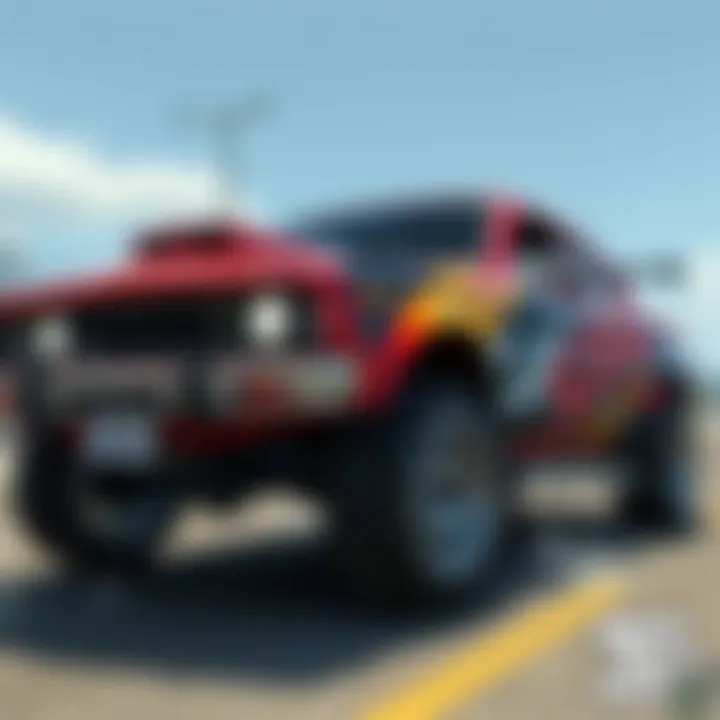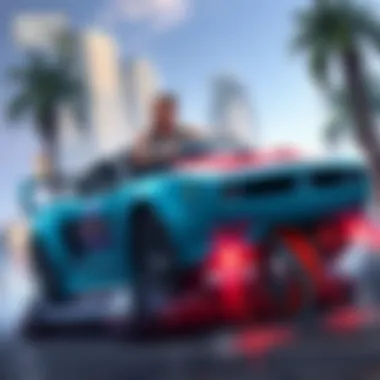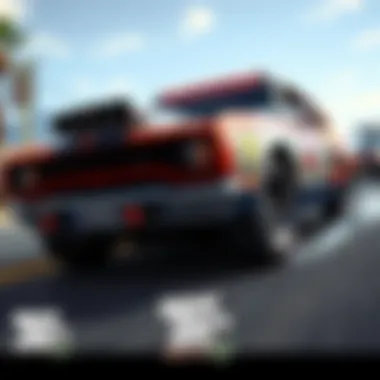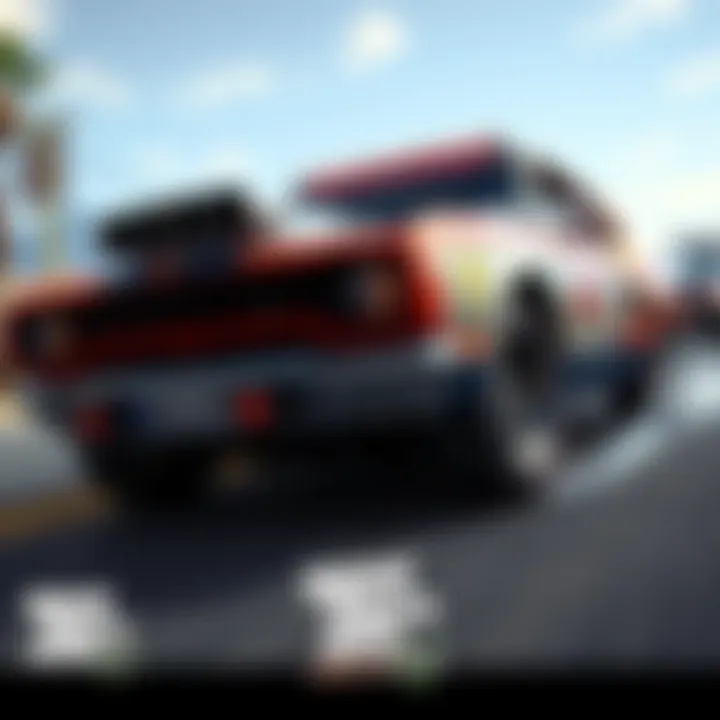Understanding Smash Car Games: Origins and Impact


Intro
The world of gaming evolves at a breakneck pace, and one genre that has consistently captured the imagination of players is the smash car game. These exhilarating experiences revolve around high-speed chases, adrenaline-pumping crashes, and the unyielding thrill of destruction. From its origins to contemporary iterations, the genre has forged a unique identity that resonates with both casual players and devoted enthusiasts alike.
In this exploration, we will navigate the winding roads of smash car games, beginning with their historical roots and progressing into the core mechanics that define their gameplay. We will analyze characters that convey complex narratives and shed light on both prominent missions and engaging side quests. Moreover, the vast array of vehicles and weapons serve not only as tools for gameplay but also as symbols of the genre's evolution.
To grasp the full impact of smash car games, one must examine how these titles reflect cultural shifts and player engagement. Stars of the gaming world, whether they be leading characters or mechanically unique vehicles, contribute to a rich tapestry blending art and commerce. Ultimately, this article aims to provide insights that benefit the gamer, collector, and creator alike, revealing how smash car games tick and why they hold enduring appeal.
As we embark on this journey, one thing stands clear: smashing through obstacles doesn't just mean demolishing walls or racing rivals; it also presents a metaphor for breaking barriers in game design and storytelling, a testament to the vibrant world of gaming that continues to baffle and amaze.
Understanding the Smash Car Game Genre
The genre of Smash Car games has carved its niche in the landscape of video gaming. These games, known for their exhilarating blend of speed, mayhem, and destruction, offer players a unique form of interactive entertainment. But why is understanding this genre so vital? For starters, it reveals underlying principles governing player engagement, inspiration for design strategies, and the broader implications of its cultural impact. The essence of these games transcends mere entertainment; they encapsulate a fascination with chaos and control, drawing in players from all corners of the gaming world.
Defining Smash Car Games
At its core, Smash Car Games are a blend of vehicular mayhem and competitive challenges, where players drive vehicles through destructible environments. Instead of strictly focusing on racing, these games emphasize the destruction and chaos one can create. Think about titles like Burnout or Destruction Derby. They allow players not only to race but to crash into opponents and obstacles, creating havoc at high speeds.
These games typically showcase:
- Destructive Environments: Gamers delight in demolishing anything in their way, from fences to entire buildings.
- Variety of Vehicles: Players can often choose from an eclectic mix of cars, trucks, and sometimes even wildlife in some funky versions.
- Engaging Physics: Companies prioritize realistic physics engines, making crashes look satisfying and impactful ; this is key to their appeal.
Historical Context
To fully appreciate the allure of Smash Car games, we must peer into their history. The roots of this genre stretch back to the early 1990s. Titles like Destruction Derby and Twisted Metal were pioneers, combining vehicular carnage with engaging gameplay. These early games showcased how players could tap into their wild side, letting loose in environments ripe for destruction.
As technology advanced, so did the genre. The introduction of more sophisticated graphics and physics engines shaped the expectations of players. In the modern era, games such as Burnout Paradise and FlatOut offered expansive worlds with intricate designs, inviting players to wreak havoc in new ways. The interest in these games has not dwindled, as their evolution now bridges mobile platforms and virtual reality, proving that the desire to smash, grind, and demolish is timeless.
"The essence of Smash Car games lies in their ability to evoke the primal joys of destruction while offering a playful environment for competition."
Understanding these foundational elements allows fans to appreciate the genre's evolution and its impact on contemporary gaming culture. With each iteration, these games continue to enchant players, transforming chaos into art and competition, echoing a tradition that began decades ago.
Core Gameplay Mechanics
In the realm of smash car games, core gameplay mechanics serve as the backbone that supports player engagement and overall experience. Understanding these mechanics is crucial to unravel the unique aspects that define the genre. They're not just rules; they are the tactile means through which players experience the game world.
Destruction Systems
Physical Interactions
Physical interactions are pivotal in smash car games. They encompass how vehicles collide with each other and with the environment. This aspect adds a layer of realism and excitement, engaging players in a visceral experience as they watch structures crumble and opponents careen into each other. One key characteristic of physical interactions is the use of real-time physics simulations, which bring authenticity to every crash and explosion. This feature keeps players coming back for more, as each session feels unique, given the unpredictability of physics.
However, there are downsides; poorly optimized physics can lead to frustrating moments that break immersion. For example, when a player's car inexplicably gets wedged into a wall following a crash, the careful design is thrown out the window, leading to sour gameplay experiences. Ultimately, the benefit of engaging physical interactions outweighs the potential pitfalls when executed well, enhancing player enjoyment substantially.
Collision Dynamics
Collision dynamics play a vital role in determining the outcome of encounters between vehicles in smash car games. This aspect includes aspects such as speed, angle of impact, and the types of vehicles involved during crashes. Collision dynamics create a variety of distinct consequences, ranging from spectacular wrecks to strategic tactics that players can utilize. The key characteristic here is the use of detailed collision detection algorithms that make these interactions feel more lifelike.
Yet, one unique feature of collision dynamics is their effect on gameplay progression. Players often learn to navigate the game smarter after experiencing the consequences of their actions, sharpening their skills over time. The risks associated with high-speed crashes or tactical ramming can lead to rewarding strategies, providing an educational component as players become familiar with the game's physics and nuances. However, if collision dynamics are inconsistent or unrealistic, it can frustrate players, resulting in a disconnect from the immersive experience the game seeks to provide.
Player Objectives and Challenges
As players immerse themselves in smash car games, they encounter a myriad of objectives and challenges that make each session compelling. These elements not only provide motivation but also define victory conditions.
Level Designs


Level designs are critical in shaping player experience within smash car games. They serve as the playground where all the mechanics come into play. The variety in level design allows players to navigate different terrains, from urban landscapes to desolate wastelands, each uniquely catering to different play styles. An important characteristic is the layout complexity—levels often introduce a mix of open spaces and intricate structures, compelling players to adapt quickly.
A unique aspect of level designs is their capacity to encourage exploration. Players might discover shortcuts or hidden areas that offer advantages in competition. However, if a level is overly convoluted, it might frustrate players, causing them to lose sight of their objectives. Hence, a balanced level design contributes significantly to player satisfaction and replayability.
Scoring Systems
Scoring systems form another essential component of smash car gameplay. They dictate how players earn points and achievements, encouraging competitive play and mastery of game mechanics. The key characteristic of scoring systems within this genre often includes multipliers based on performance, such as maintaining speed or executing unique stunts during destruction.
Additionally, a unique aspect of scoring systems can be seen in how they foster community engagement. Players often compare scores on leaderboards, creating a friendly rivalry that adds another layer of excitement. However, a poorly structured scoring system could lead to imbalances, where players find loopholes and exploit them for higher scores, frustrating those engaging in fair play. Thus, a well-thought-out scoring system is not just about rewarding actions; it significantly influences community dynamics within the game.
In summary, the core gameplay mechanics of smash car games are deeply intertwined with the player's experience, offering a rich canvas of interactions and challenges. The balance between destruction systems, player objectives, and scoring intricacies ultimately shapes the appeal and longevity of this unique gaming genre.
Visual Aesthetics and Design Elements
When it comes to the smash car game genre, visual aesthetics and design elements play a pivotal role in shaping player experiences. The imagery isn't just eye candy; it serves deeper purposes that influence gameplay and emotional engagement. A cleverly designed environment can elevate a straightforward concept into a captivating game, enhancing player immersion and excitement.
Art Style Evolution
The journey of art styles in smash car games has been nothing short of transformative. Early iterations leaned heavily on simplistic, cartoon-like graphics, which allowed for rapid development and brought in immediate fun. Over the years, however, the industry's pushing boundaries like nobody's business. New artistic trends merge realism with the outrageous, creating a unique blend that visually wowed gamers.
Consider the evolution from a game like Crash Team Racing, whose graphics emphasized vibrant colors and whimsical characters, to modern titles such as Wreckfest, which offers detailed environments and realistic car damage. This transition showcases how developers have tapped into technology to create immersive worlds.
- Incorporating different art forms: Stylized designs often use bold lines and high saturation, while realistic graphics might lean towards nuanced shading and textures that reflect light. This diversity doesn't merely enhance visual appeal but also serves functional purposes, aiding in decision-making during high-adrenaline moments.
- Trends in art style: Classes of art can denote the mood or genre — from dystopian themes in Mad Max: Fury Road to cartoonish mayhem in Destruction AllStars. Each art style attracts different gamer demographics, tapping into their interests and expectations.
This evolution has been spurred not just by technological advancements but also by fans expressing desires for richer visual experiences. It's a cycle: player feedback drives artistic direction, which in turn shapes future gameplay.
Environmental Interactivity
Next, we delve into the intricacies of environmental interactivity. In smash car games, the surroundings are not just a backdrop; they are integral components that can provide tactical advantages or, conversely, hinder progress.
- Dynamic environments: Elements like destructible scenery, like fences, buildings, and obstacles, can elevate the gameplay. For instance, smashing through a wall not only adds to the chaos but can also provide strategic shortcuts. Games like Burnout Paradise have exemplified this by offering players multiple pathways and leveraging the destructibility of their surroundings.
- Player impact and realism: The way a car reacts to different surfaces—whether it's encountering mud, asphalt, or gravel—also shapes the player's engagement. Getting stuck in thick mud or losing control on slick roads adds layers of realism and keeps players coming back for more.
- Feedback loops: Feedback from the environment, such as visual cues or sound effects when smashing through objects, offers satisfying reinforcement for players' actions. Such immediate feedback is crucial in creating a sense of agency and empowerment, where every destructive act resonates both visually and audibly.
Technological Advancements
The realm of smash car games has witnessed a whirlwind of technological developments that have propelled the genre forward at a breathtaking pace. From the simple pixelated designs of early iterations to the visually stunning environments of contemporary titles, these advancements are not merely aesthetic. They shape gameplay experiences, influence player engagement, and establish the very framework that defines how these games are played.
Physics Engines
At the heart of any smash car game lies its physics engine. Think of it as the backbone, the unseen force that governs the interactions between cars, environmental elements, and obstacles on the map. A good physics engine does more than just simulate car behavior; it brings the entire world to life.
The realism achieved by modern physics engines allows for spectacular destruction sequences, where a car crashes into a building with fragments flying as if they were real. For instance, games like BeamNG.drive showcases this remarkably, where players can experiment with vehicular mechanics in an open-world setup, proving how physics can enhance gaming.
- Realism: Modern engines like Havok and Bullet Engine utilize complex algorithms that take into account inertia, weight distribution, and even tire traction. This means when a car flips or crashes, it feels real, enhancing immersion.
- User Interaction: Players can influence their environment. Whether it’s smashing through barriers or sending debris flying, each action is calculated, making the experience rewarding.
- Variation in Gameplay: Different engines can dictate how collisions work, which directly influences game design. Strategies evolve based on how players can manipulate their environment, offering varied gameplay experiences that keep players on their toes.
This focus on intricate physics isn’t just for show; it's pivotal in crafting the tension and excitement players crave. Each crash and smash carries weight, making success feel truly earned.
AI and NPC Interactions
Artificial intelligence (AI) plays a surprisingly nuanced role in smash car games, impacting gameplay well beyond simplistic enemy interactions. The ability for non-player characters (NPCs) to respond dynamically to player actions adds layers of unpredictability and engagement.
In many smash car games, NPCs aren't just obstacles; they can engage with the player in ways that enhance the experience. Whether they offer challenges or simply add to the chaos of a level, they help create a vibrant gaming ecosystem.
- Adaptive Behavior: Through machine learning algorithms, NPCs can learn from player patterns, making them unpredictable. Players can’t just rely on tried-and-true strategies; they must adapt.
- Realistic Reactions: Advanced AI allows NPCs to react in a believable manner. If a player is barreling down a road, NPCs might swerve or attempt to escape rather than sticking to a programmed path. This unpredictability adds excitement and realism.
- Enhanced Interactivity: Some games allow NPCs to not just act but to react to player decisions, contributing to a more immersive narrative. Imagine a scenario where an NPC might assist or challenge a player based on previous interactions, adding layers to gameplay depth.
In many ways, AI serves as an unsung hero in smash car games, ensuring that each playthrough feels unique. No two gaming sessions are entirely alike, enhancing replayability and keeping players returning for more.
The integration of physics engines and AI transforms traditional gameplay into an immersive experience, bridging the gap between player intent and game world response.


Ultimately, the technological advancements in smash car games signify more than just updated graphics or smoother mechanics; they usher in a new era where the gameplay experience is richer, more exciting, and endlessly engaging for players.
Cultural Impact of Smash Car Games
The smash car game genre has carved out a significant niche within the realm of interactive entertainment, resonating with audiences far beyond casual gaming. This genre serves as a splendid example of how gaming can intertwine with culture, influencing and reflecting societal trends. More than just a collection of games where players demolish vehicles and structures, the impact of smash car games is woven into the fabric of popular culture and community engagement.
Influence on Popular Media
Smash car games have made their mark in popular media, inspiring a variety of cultural phenomena. From action-packed movie adaptations to references in television shows, the genre's chaotic and thrilling nature translates seamlessly into various forms of entertainment. Many films, such as the "Fast & Furious" franchise, have embraced elements reminiscent of smash car gameplay, showcasing high-octane stunts and destructive car chases that mirror the gameplay mechanics that players have come to love.
Moreover, advertising agencies often tap into the smash car aesthetic to promote products, utilizing the allure of destruction to capture audience attention. Think of high-energy car commercials that invoke the exhilarating destruction found in smash car experiences. This cross-pollination between games and media underscores the genre's ability to spark creativity beyond its digital confines.
Community and Fandom
The smash car game community thrives through forums and competitive events, both of which facilitate connections among fans.
Online Forums
Online forums provide a hub for gamers to share tips, tricks, and personal experiences. These platforms cultivate a vibrant atmosphere where enthusiasts can engage with one another. A notable characteristic of these forums is their accessibility, allowing new players to get involved quickly. The charm lies in how seasoned players mentor newcomers, often lasting long after a game’s initial release.
In these spaces, discussions can range from game mechanics to fan theories about potential sequels or updates. One unique feature is the ability for fans to create mods or new levels, essentially extending the life of the game and fostering creativity within the community. However, it's worth noting that the quality of forums can vary, leading to debates on which platforms provide the best experiences.
Competitive Events
Competitive events solidify the smash car game's standing within the gaming spectrum by showcasing player skill and strategy. These tournaments often attract a mix of casual gamers and die-hard fans, offering a stage to display talent and creativity. A standout feature of these competitive events is the community spirit they generate. Participants and spectators alike revel in the excitement, cheering for their favorite players, which fosters a sense of belonging.
Nevertheless, organizing such events can present challenges, particularly concerning balancing competition and casual enjoyment. Yet, the buzz surrounding these gatherings often leads to fruitful discussions on social media, further amplifying the game's appeal.
"Gaming communities thrive on competition, but it’s the camaraderie built over shared experiences that truly unites players."
This cultural exchange illustrates how smash car games have not only provided entertainment but have also opened doors for social interaction and bonding. Through media influence and community engagement, the genre has cemented its relevance, continuing to evolve alongside advancements in technology and shifts in gamer preferences.
Comparative Analysis with Other Genres
Comparative analysis of smash car games with other genres offers a nuanced perspective on what sets this category apart within the vast landscape of video games. Understanding how smash car games differ from their counterparts not only enhances appreciation for the genre but also sheds light on the mechanics that resonate deeply with players. By contrasting smash car games with traditional racing games and blending elements from action and strategy genres, we can grasp how they carve their niche in a crowded market.
Racing vs. Smash Car Games
Racing games have long been a staple in gaming culture, championing speed, precision, and competitive spirit. Players often aim for the finish line, navigating through meticulously designed tracks while managing vehicle dynamics and techniques. Take titles like Forza Horizon or Need for Speed; they thrive on realism and mastery of driving skills.
In contrast, smash car games embrace a more chaotic and destructive philosophy. The goal is less about racing to outrun competitors and more about engaging in panoramic carnage. The tracks or arenas often serve as a playground for players to smash into obstacles, unleash mayhem, and accrue damage points rather than recording lap times.
Key differences between the two genres include:
- Primary Objectives: Racing games focus on speed and precision, while smash car games emphasize destruction and exploration.
- Player Experience: In racing, gaining mastery over control can be key. In smash car games, players often find enjoyment in the ad hoc nature of gameplay, where outcomes can be unpredictable.
- Game Environments: Smash car titles often feature more open-world designs, promoting exploration and non-linear progression, which deviates from the confined tracks of traditional racing games.
This distinction allows players to immerse themselves in different types of gaming experiences, catering to varying preferences—some seek the adrenaline of competition, others revel in the cathartic release of destruction.
Action and Strategy Elements
Smash car games do not just rely on physics and destruction. They often incorporate action and strategic components that deepen the gameplay. The frenetic pace of the game often requires tactical thinking. Players must assess their surroundings and make rapid decisions to gain the upper hand over opponents.
In games like Destruction AllStars, timing is critical. Players must strategically decide when to charge into opponents and when to dodge. This strategic layer adds depth to the root action gameplay. Here’s how smash car games intertwine action with strategy:
- Timing and Reaction: Players need to maintain quick reflexes while also planning their next moves. It’s a blend of instinctual reactions and calculated strategy.
- Resource Management: Some smash car games include weaponry or power-ups, requiring players to manage available resources effectively—using them at the right moment can turn the tide of a match.
- Environmental Awareness: Players must capitalize on environmental elements to outsmart opponents, perhaps by using cover or leveraging destructible assets in the arena.
This blend of action and strategy makes smash car games more than just chaotic destruction; it turns them into a battlefield of minds and reflexes.


"The beauty of smash car games lies not just in the havoc they wreak, but in the strategies players concoct amid the mayhem. It’s the thrill of disaster with a dash of wit that keeps fans coming back."
The comparative analysis of smash car games against racing and action genres reveals their unique essence. With their emphasis on destruction, player strategy, and the thrill of the unexpected, smash car games stand out, proving to be captivating for both seasoned gamers and newcomers alike.
For further insights on game genre comparisons, check resources like Wikipedia or Britannica. Additional community discussions can be found on Reddit where gamers share their experiences and views on genre developments.
Market Dynamics and Commercial Success
The market dynamics surrounding smash car games underscore their vitality in today’s gaming landscape. Several factors contribute to the commercial success of this genre, highlighting its ability to attract a diverse audience and maintain engagement.
Smash car games thrive on an adrenaline-fueled gameplay that captivates players. It’s not just about dismantling vehicles; it’s the sheer thrill of creating chaos and the satisfaction derived from watching things go boom. This sense of empowerment resonates with players, drawing them into a world where destruction equates to fun. Gamers today are not just looking for challenges but for visceral experiences that spark joy and excitement.
Monetization Strategies
Monetization in smash car games takes several forms, each designed to enhance player engagement while generating revenue. A few prominent approaches include:
- In-app Purchases: Players often have the option to buy vehicle upgrades, customization elements, or new game modes. These purchases can significantly enhance the gameplay experience, encouraging spend.
- Ads Integration: Free-to-play models frequently incorporate advertisements, ranging from banner ads to rewarded video ads, allowing gamers to earn rewards through viewing.
- Premium Versions: Offering a paid version of the game without interruptions or ads appeals to players who desire an uninterrupted experience. This model can attract dedicated gamers willing to pay upfront for quality.
Implementing these strategies effectively requires awareness of player preferences and behavior. For instance, many players may appreciate the liberty to customize their vehicles fully or experience exclusive content. Therefore, tailoring monetization efforts to meet anticipated needs becomes essential.
Sales Trends in the Genre
The sales trends for smash car games reveal a thriving market. Analyzing data over the years reveals interesting insights:
- Consistent Growth: Sales have shown not only resilience but consistent growth, particularly in the last few years. With games like Burnout and Destruction AllStars receiving renewed interest, this genre is proving its staying power.
- Target Audience: The demographic spans from casual gamers to hardcore enthusiasts. Smash car games appeal to those who seek an accessible gaming experience while providing depth for those willing to invest time.
- Rise of Multiplayer Modes: Many successful titles have integrated multiplayer features. This shift reflects a trend where friends engage in lively battles, enhancing social interaction.
"The smash car genre doesn’t just foster solo play; it cultivates community—players rally around shared experiences and competitive spirit."
For further reading on gaming trends and market analysis, check out reliable sources like Wikipedia and Britannica.
The Future of Smash Car Games
As we look forward to the future of smash car games, it becomes critical to consider not just the evolution of gameplay but also how emerging technologies and player expectations shape the genre. The next wave of innovations may very well redefine the experience, paving the way for more immersive and enjoyable interactions. Understanding these potential shifts helps our comprehension of where this genre is heading and how it will continue to engage a varied audience of gamers.
Trends to Watch
Several trends are emerging that stand to impact smash car games significantly:
- Integration of Virtual Reality (VR): With growing advancements in VR technology, the possibility of offering players an immersive in-car experience looms large. Imagine smashing cars and feeling the impacts in real-time. VR not only enhances player engagement but also transforms the world of the game into a more sensory-rich environment.
- Augmented Reality (AR) Features: Following VR’s footsteps, AR can create a unique blend of the real world with the in-game universe. Just think about players racing through the streets of their hometown, with obstacles and objectives that appear only through their devices. This can expand the gameplay beyond traditional boundaries and into daily life.
- Procedural Generation: Future titles may leverage procedural generation to create new and unique gaming environments. This technique can give players something fresh every time they log in. New challenges can arise on every playthrough, keeping interest alive longer and encouraging replayability.
- Cross-Platform Compatibility: As gaming unites players across various devices, smash car games could adopt a cross-platform approach, allowing friends to engage with each other regardless of their gaming system, whether it be console, PC, or mobile. This trend can potentially broaden the player base and foster a stronger community around these games.
Potential Innovations
With trends in mind, let’s explore some specific innovations that could become staples in the future smash car games:
- Enhanced Destruction Physics: Future games might develop more sophisticated physics engines. This means not only could players smash cars, but also interact with their environment on a deeper level — walls crumbling, trees falling, and even buildings taking damage. These elements add realism, increasing player satisfaction.
- AI-Driven NPCs: Imagine cars driven by intelligent NPCs that learn from the player’s actions. Instead of repeatable patterns, these AI could adapt and present a real challenge, requiring strategic thinking and adaptable tactics from players.
- Shared World Environments: Multiplayer options may evolve to create shared worlds where players can encounter each other in real-time, with the potential to collaborate or compete against others. This environment can enhance the community aspect of smash car games, allowing for cooperative missions or even competitive rounds.
- Real-Time Event Integration: Future smash car games might mesh with real-world events, much like current online experiences do. Players could engage in special in-game events related to holidays, festivities, or even global awareness campaigns, making the experience feel more timely and relevant.
The future of smash car games is bright with possibilities. As technology grows and player demands evolve, we can expect a richer, more complex set of experiences that not only challenge players but also invite them to immerse themselves in dynamic worlds. The genre might evolve into something beyond mere gaming — a cultural touchstone that resonates with larger societal trends, lifestyles, and innovations.
The End and Wrap-Up
The conclusion serves as a vital focal point in this article, encapsulating the journey through the smash car game phenomenon. It is essential since it ties together the various threads discussed throughout the piece, reinforcing the significance of understanding this genre. Smash car games are not merely about mindless destruction; they are intricately woven into the fabric of gaming culture, showcasing artistic innovation, community engagement, and evolving technology.
- Importance of the Genre: The smash car genre stands out due to its unique blend of chaos and creativity. By examining its mechanics and cultural impact, readers gain insight into why these games attract substantial player bases.
- Benefits of Understanding: Recognizing the elements that drive player engagement is crucial for developers and marketers alike. By understanding gameplay dynamics, scoring, and community aspects, stakeholders can tailor experiences that resonate with audiences, enhancing both enjoyment and profitability.
- Considerations for the Future: As we consider the trajectory of smash car games, we can anticipate continued innovation, informed by both technological advancements and changes in player preferences. This genre is likely to evolve, reflecting broader trends in the gaming industry.
Key Takeaways
- Integral Engagement: Smash car games capture player interest through dynamic environments and engaging challenges.
- Cultural Relevance: These games have influenced not only gaming but also various aspects of popular media, creating a ripple effect across entertainment.
- Market Dynamics: Understanding the commercialization strategies can provide insight into the economic viability of this genre.
- Future Innovations: With technology advancing, we can expect new trends and features that will redefine gameplay and player experiences.
Final Thoughts
In concluding our exploration of the smash car game genre, one must appreciate its multilayered nature. It's a sector that melds art, technology, and community spirit. The ability to smash cars while engaging in intricate strategies offers a unique satisfaction that resonates with players of all ages. As gamers seek new experiences, the potential for growth in this genre remains vast.
To fully appreciate where it stands today, players and developers alike should keep their fingers on the pulse of trends and innovations. The evolution of smash car games promises to bring fresh experiences, keeping the genre compelling and relevant in the ever-changing world of interactive entertainment.



